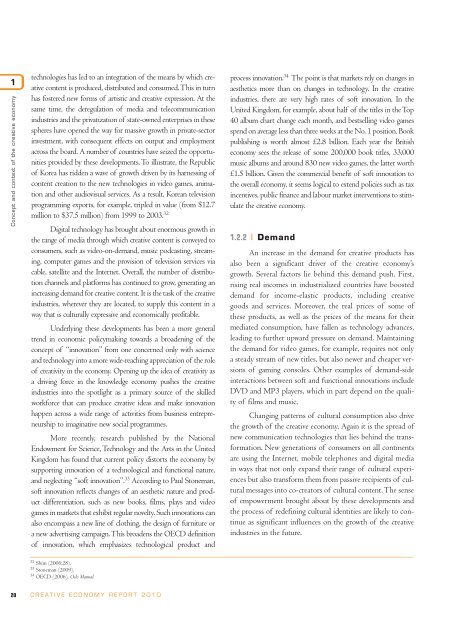Creative Economy: A Feasible Development Option
Creative Economy: A Feasible Development Option
Creative Economy: A Feasible Development Option
- No tags were found...
You also want an ePaper? Increase the reach of your titles
YUMPU automatically turns print PDFs into web optimized ePapers that Google loves.
1Concept and context of the creative economytechnologies has led to an integration of the means by which creativecontent is produced, distributed and consumed. This in turnhas fostered new forms of artistic and creative expression. At thesame time, the deregulation of media and telecommunicationindustries and the privatization of state-owned enterprises in thesespheres have opened the way for massive growth in private-sectorinvestment, with consequent effects on output and employmentacross the board. A number of countries have seized the opportunitiesprovided by these developments. To illustrate, the Republicof Korea has ridden a wave of growth driven by its harnessing ofcontent creation to the new technologies in video games, animationand other audiovisual services. As a result, Korean televisionprogramming exports, for example, tripled in value (from $12.7million to $37.5 million) from 1999 to 2003. 32Digital technology has brought about enormous growth inthe range of media through which creative content is conveyed toconsumers, such as video-on-demand, music podcasting, streaming,computer games and the provision of television services viacable, satellite and the Internet. Overall, the number of distributionchannels and platforms has continued to grow, generating anincreasing demand for creative content. It is the task of the creativeindustries, wherever they are located, to supply this content in away that is culturally expressive and economically profitable.Underlying these developments has been a more generaltrend in economic policymaking towards a broadening of theconcept of “innovation” from one concerned only with scienceand technology into a more wide-reaching appreciation of the roleof creativity in the economy. Opening up the idea of creativity asa driving force in the knowledge economy pushes the creativeindustries into the spotlight as a primary source of the skilledworkforce that can produce creative ideas and make innovationhappen across a wide range of activities from business entrepreneurshipto imaginative new social programmes.More recently, research published by the NationalEndowment for Science, Technology and the Arts in the UnitedKingdom has found that current policy distorts the economy bysupporting innovation of a technological and functional nature,and neglecting “soft innovation”. 33 According to Paul Stoneman,soft innovation reflects changes of an aesthetic nature and productdifferentiation, such as new books, films, plays and videogames in markets that exhibit regular novelty. Such innovations canalso encompass a new line of clothing, the design of furniture ora new advertising campaign. This broadens the OECD definitionof innovation, which emphasizes technological product andprocess innovation. 34 The point is that markets rely on changes inaesthetics more than on changes in technology. In the creativeindustries, there are very high rates of soft innovation. In theUnited Kingdom, for example, about half of the titles in the Top40 album chart change each month, and bestselling video gamesspend on average less than three weeks at the No. 1 position. Bookpublishing is worth almost £2.8 billion. Each year the Britisheconomy sees the release of some 200,000 book titles, 33,000music albums and around 830 new video games, the latter worth£1.5 billion. Given the commercial benefit of soft innovation tothe overall economy, it seems logical to extend policies such as taxincentives, public finance and labour market interventions to stimulatethe creative economy.1.2.2 DemandAn increase in the demand for creative products hasalso been a significant driver of the creative economy’sgrowth. Several factors lie behind this demand push. First,rising real incomes in industrialized countries have boosteddemand for income-elastic products, including creativegoods and services. Moreover, the real prices of some ofthese products, as well as the prices of the means for theirmediated consumption, have fallen as technology advances,leading to further upward pressure on demand. Maintainingthe demand for video games, for example, requires not onlya steady stream of new titles, but also newer and cheaper versionsof gaming consoles. Other examples of demand-sideinteractions between soft and functional innovations includeDVD and MP3 players, which in part depend on the qualityof films and music.Changing patterns of cultural consumption also drivethe growth of the creative economy. Again it is the spread ofnew communication technologies that lies behind the transformation.New generations of consumers on all continentsare using the Internet, mobile telephones and digital mediain ways that not only expand their range of cultural experiencesbut also transform them from passive recipients of culturalmessages into co-creators of cultural content. The senseof empowerment brought about by these developments andthe process of redefining cultural identities are likely to continueas significant influences on the growth of the creativeindustries in the future.32 Shim (2006:28).33 Stoneman (2009).34 OECD (2006), Oslo Manual.20 CREATIVE ECONOMY REPORT 2010
















